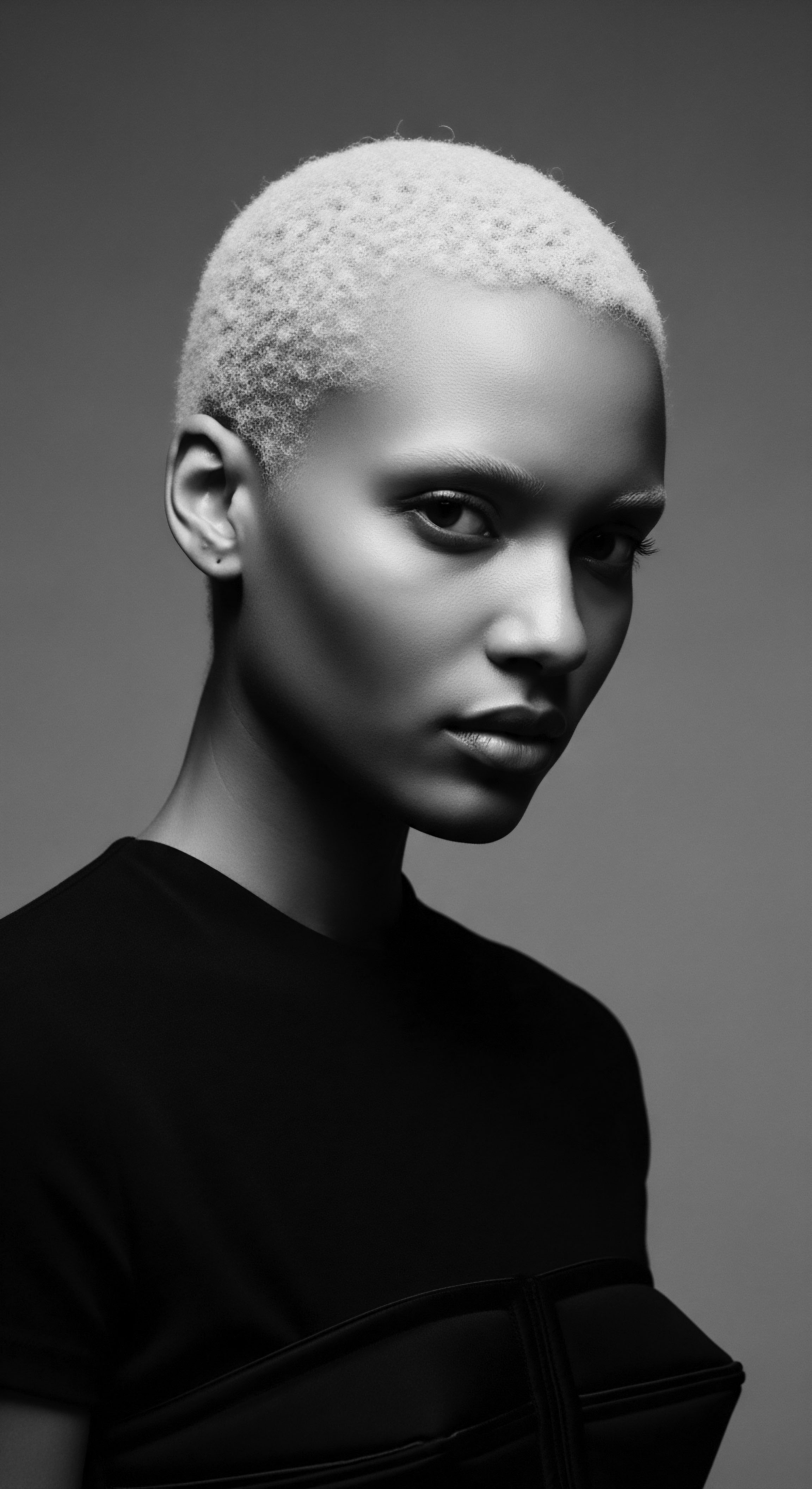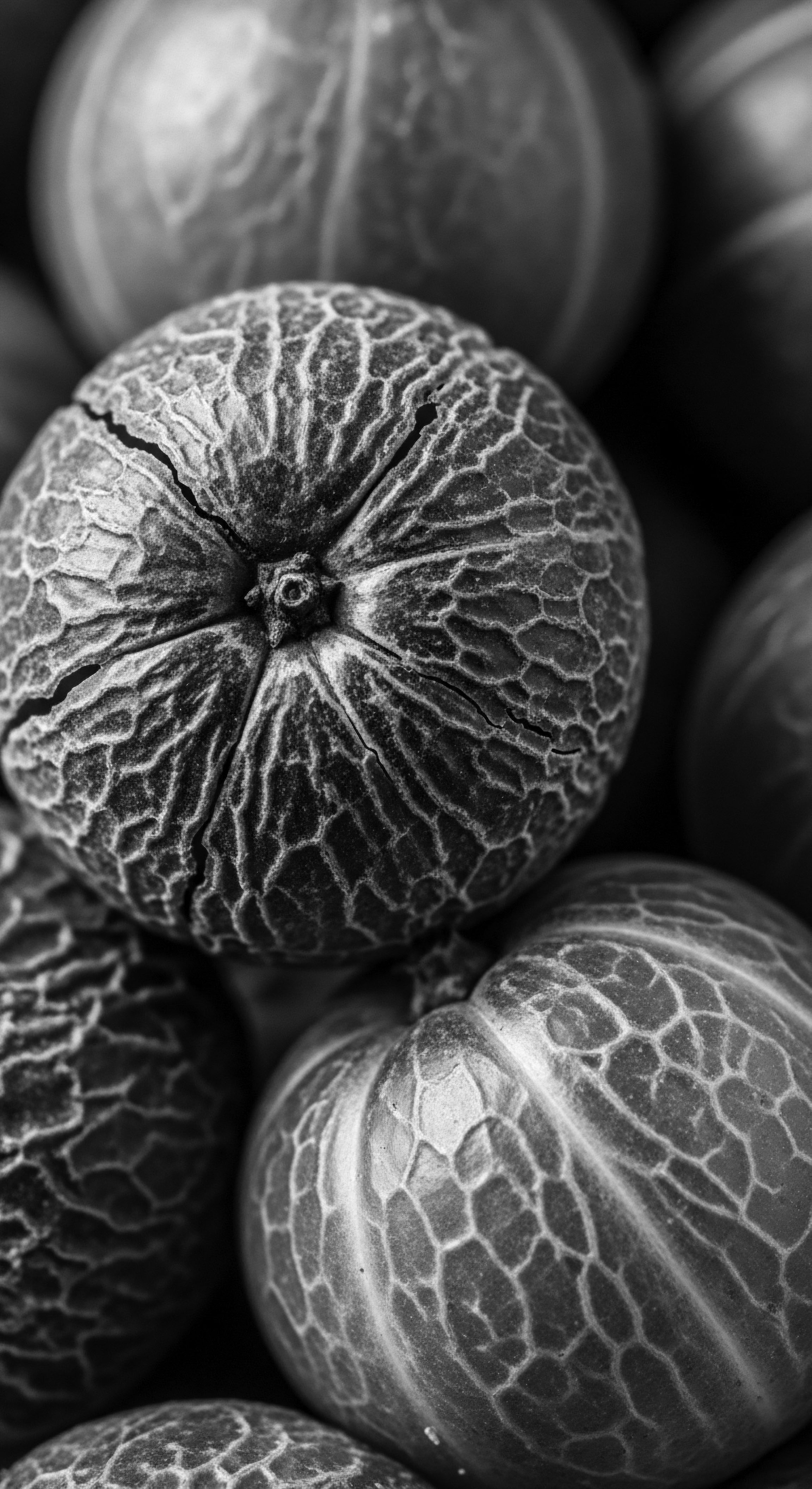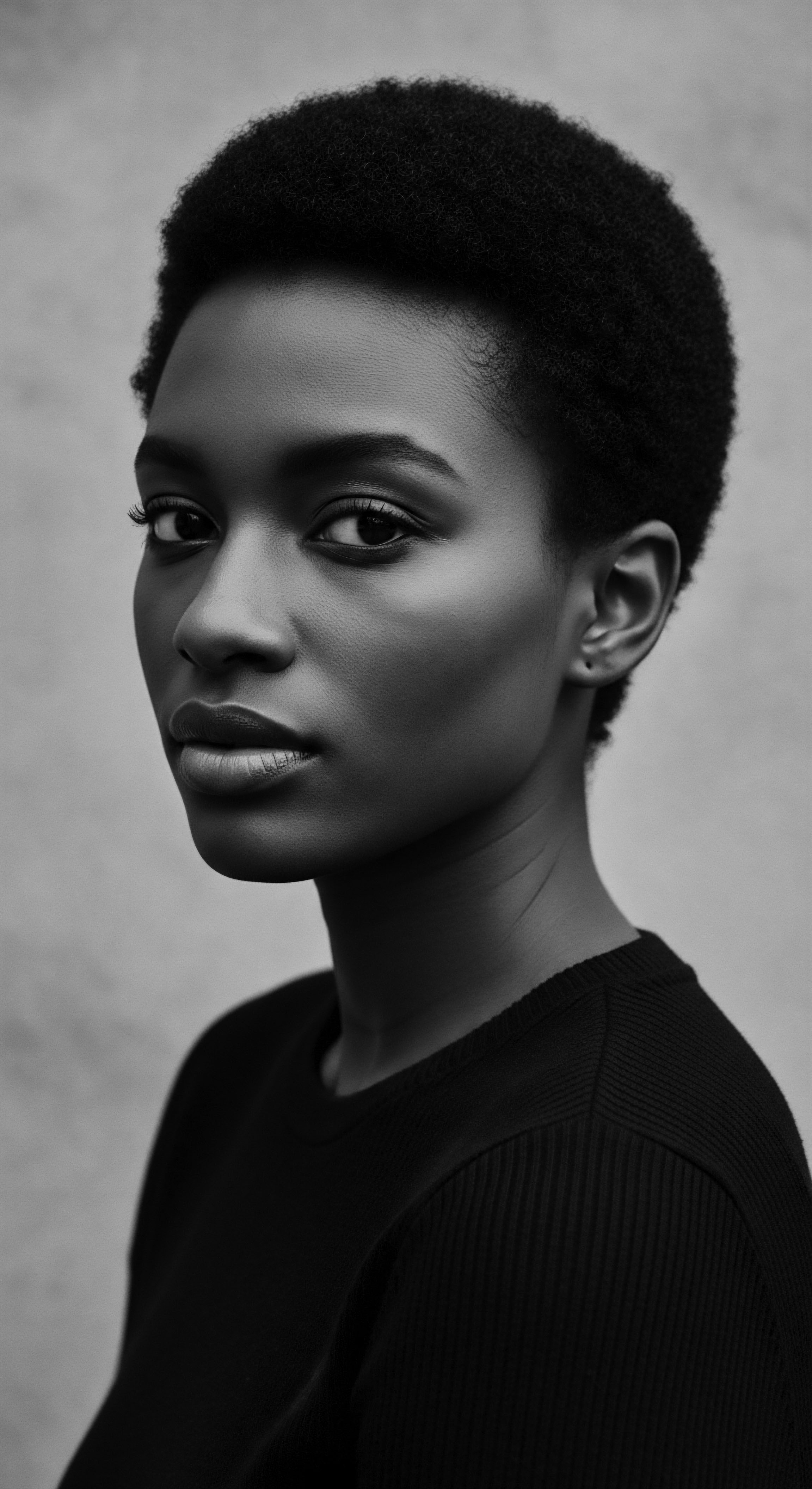
Roots
Across generations, spanning sun-drenched landscapes and whispered lore, the essence of textured hair finds its deep lineage within the very fibers that spring from our crowns. This heritage, so vibrant and resilient, holds within its intricate patterns centuries of wisdom, care, and purposeful connection to the earth’s offerings. To truly grasp the traditional ways henna supported textured hair’s well-being, one must first recognize the hair itself not as a mere appendage, but as a living archive, a scroll upon which ancestral practices were meticulously inscribed. It is within this understanding that the story of henna, the ancient plant, begins to truly unfold, revealing its sacred place in a pantheon of plant-based remedies passed down through time.
For communities across North Africa, the Middle East, and South Asia – and, by extension, within the diaspora – the red-orange pigment derived from the Lawsonia Inermis plant, known widely as henna, was far more than a cosmetic tint. Its utility extended into realms of healing, ritual, and protection, all deeply interwoven with daily life and the care of hair that defied neat categorizations. This plant, with its cooling properties and its ability to lend strength, became a trusted companion in managing the unique qualities of coily, curly, and wavy hair types long before scientific instruments could dissect its molecular structure.

The Hair’s Intrinsic Design
Textured hair, at its elemental core, presents a magnificent architectural marvel. Its elliptical cross-section, the twisting and turning of the strand, and the often varying cuticle layers create a complex landscape that requires thoughtful engagement. Traditional healers and caregivers, through keen observation and iterative practice, discerned that these very characteristics—the natural coils and bends—could make textured strands more prone to dryness and breakage at the points of curvature.
This empirical understanding, though lacking modern microscopic validation, informed their choice of emollients and fortifiers, among them, henna. They intuitively knew that robust, well-nourished hair possessed greater resilience against environmental stressors and the wear of daily manipulations.
The ancestral knowledge of hair anatomy, while not articulated in molecular terms, focused instead on the hair’s lived experience. The strength of a strand, its ability to retain moisture, and its resistance to splitting were all indicators of well-being. Henna, observed to bind to the keratin protein within the hair shaft, was seen to impart a protective layer, lending substance to what might otherwise be delicate spirals.
Ancestral wisdom views textured hair not as a challenge, but as a living testament to a rich lineage, where each coil and curl tells a story of enduring beauty.

What Ancestral Knowledge Guided Henna’s Use?
The use of henna was often guided by a holistic approach, where the body, spirit, and community were seen as interconnected. Decisions regarding hair care were not isolated acts of vanity but were instead integrated into broader wellness practices and cultural expressions. For textured hair, this often meant a focus on protecting the scalp, promoting growth, and maintaining the hair’s structural integrity against the elements, practices that spanned generations.
- Scalp Health ❉ Henna’s natural antifungal and antibacterial properties were recognized. Traditional preparations often included other herbs to create poultices that soothed irritated scalps, addressed dandruff, and provided an optimal environment for hair growth. A healthy scalp, they understood, was the foundation for strong hair, particularly for hair types that retained more natural oils and could be prone to buildup.
- Conditioning and Strengthening ❉ The fine powder of the dried henna leaves, when mixed with warm liquid, created a paste that, upon application, coated the hair shaft. This coating was seen to impart a noticeable difference in the hair’s feel, making it appear thicker and more robust. For hair that might otherwise feel fragile, this added fortification was a significant benefit, reducing instances of breakage.
- Color and Adornment ❉ While its primary benefit for well-being was often structural, the deep, earthy hues henna provided were also integral to its traditional use. This color, a sign of vitality and often associated with celebratory rites, contributed to the hair’s perceived health and beauty, boosting morale and identity within communities.
These ancestral insights into hair care, rooted deeply in the observation of nature’s offerings, set the stage for henna’s enduring prominence. The plant became a symbol of well-being, its traditional applications mirroring an intuitive grasp of how to work with textured hair’s innate characteristics rather than against them.

Ritual
The application of henna onto textured hair moved beyond simple utility; it became a cherished ritual, a tender act of care often performed within communal settings, particularly among women. These sessions were not merely about hair treatment; they were social gatherings, moments of intergenerational knowledge transfer, and a reaffirmation of cultural ties. Hands working in unison, sharing secrets of past blends, and humming ancient tunes, solidified the bond between the individual, their hair, and the collective memory of their people. Such rituals formed an invisible architecture of belonging, where the act of beautification was also an act of communal strengthening.
The preparation of henna for hair involved specific methods that varied subtly across regions but consistently aimed to release the dye and conditioning properties effectively. Dried henna leaves were meticulously ground into a fine powder, then typically mixed with warm water, black tea, or even acidic liquids such as lemon juice. The resulting paste, rich and earthy, was allowed to sit, often overnight, to allow for Dye Release, a process where the lawsone molecule became available to bind with the hair’s keratin. This careful alchemy, passed down through oral tradition, speaks to a sophisticated empirical understanding of the plant’s chemistry.

How Did Traditional Henna Application Methods Benefit Textured Hair?
The very nature of textured hair, with its coils and spirals, often meant that products needed to be thoroughly worked into the strands to ensure even distribution. Traditional henna application reflected this necessity, often involving painstaking sections and careful layering of the paste from root to tip. This meticulous process ensured that every part of the hair received the fortifying benefits, promoting uniformity in conditioning and color.
Consider the practices of communities in the Maghreb, where henna use is deeply embedded in cultural life. The preparation for a wedding, for instance, might involve elaborate henna ceremonies for the bride, where her hair would be drenched in the rich paste. This wasn’t just for appearance; the lengthy application and dwelling time allowed the henna to deeply condition and reinforce the hair, preparing it for intricate bridal styles that would last for days, a symbolic act of fortification for a new life stage. This ceremonial application speaks volumes about the perceived strengthening properties of henna and its role in protecting hair for enduring styles.
Henna rituals for textured hair offered more than conditioning; they were communal acts, weaving together generations through shared practice and ancestral knowledge.
One compelling historical account comes from the study of traditional North African practices, where henna was used not just for dye but for its conditioning effects on coarse hair. As noted by Westermarck (1926), in his extensive work on Moroccan rituals, henna was applied to hair not only for its reddish tint, which was considered beautiful and protective, but also because it was believed to make the hair “stronger and thicker.” This observation, made by an anthropologist noting local customs, underscores the traditional understanding of henna’s benefits for hair structure. (Westermarck, 1926)
| Traditional Application Purpose Deep Conditioning |
| Benefit for Textured Hair Heritage Helped seal the cuticle, reducing frizz and increasing definition for coils and curls. This made hair easier to manage and style into traditional braids and twists. |
| Traditional Application Purpose Hair Fortification |
| Benefit for Textured Hair Heritage Added structural integrity to delicate strands, minimizing breakage during styling and manipulation, preserving length and overall hair health for enduring styles. |
| Traditional Application Purpose Scalp Treatment |
| Benefit for Textured Hair Heritage Cleansed and soothed the scalp, addressing common issues like flaking or irritation that could impede healthy growth, a particular concern for densely coiled hair. |
| Traditional Application Purpose Natural Dye for Adornment |
| Benefit for Textured Hair Heritage Provided a revered, earthy color that signified vibrancy and cultural identity, particularly important in celebratory hairstyles and rituals. |
| Traditional Application Purpose The enduring utility of henna stems from a deep appreciation for its multifaceted contributions to both the health and aesthetic expression of textured hair across generations. |

Traditional Tools and Techniques with Henna
The tools used in traditional henna application were often simple, drawing from the natural environment or readily available household items. Hands, of course, were primary, allowing for intimate contact with the hair and scalp. Combs, often fashioned from wood or horn, aided in parting sections and distributing the thick paste. The sheer manual dexterity and patience involved in these processes speak to the reverence held for the plant and the hair it served.
Techniques employed varied from simple full-head applications to more intricate patterns applied to specific sections, sometimes for symbolic meaning. After application, hair was often wrapped in leaves, fabric, or old cloths to maintain warmth and moisture, allowing the lawsone to penetrate and bind effectively. The duration of wear was also a deliberate choice, ranging from a few hours for a conditioning gloss to overnight for deeper color and structural benefits. This commitment to extended treatment reflects a deep understanding of natural processes and the time required for transformation.

Relay
The ancestral wisdom surrounding henna, carefully relayed through generations, bridges ancient practices with contemporary understanding. This transmission of knowledge ensures that the benefits experienced by our forebears for their textured hair continue to inform and inspire holistic care regimens today. The deep, rich history of henna’s use provides a powerful lens through which to view hair wellness, moving beyond superficial aesthetics to consider the profound connection between physical well-being and cultural legacy. It’s a testament to the resilience of tradition, continually adapted yet consistently holding its ancestral core.
Modern science, with its analytical tools, has begun to parse the very mechanisms behind what ancient communities understood through observation and trial. The principal active compound in henna, Lawsone (2-hydroxy-1,4-naphthoquinone), possesses a remarkable affinity for the keratin protein that forms the backbone of hair strands. When applied as a paste, lawsone molecules bind covalently to the hair’s keratin, creating a protective film that coats the cuticle. This coating has tangible benefits for textured hair, which, due to its unique helical structure, can be more susceptible to environmental damage and mechanical stress.

What Scientific Principles Underpin Henna’s Fortifying Effects on Textured Hair?
The lawsone-keratin bond effectively adds a layer of strength and resilience to the hair shaft. This process, often referred to as ‘protein binding’ or ‘protein deposition,’ results in several observable improvements. For textured hair, this can translate to reduced porosity, allowing the hair to retain moisture more effectively. Less porous hair is less prone to sudden moisture loss, which helps maintain elasticity and prevents the brittleness often associated with dryness.
The cuticle, the outermost layer of the hair, also becomes smoother and lies flatter. This creates a reflective surface, enhancing natural luster, and reduces tangling.
A 2011 study on natural dyes, including Lawsonia inermis, highlighted its ability to improve hair fiber properties. Researchers found that plant-based dyes like henna can act as effective conditioning agents, contributing to the hair’s tensile strength and elasticity (Lall, 2011). This scientific validation echoes the anecdotal evidence and traditional knowledge accumulated over millennia, confirming that the perceived strengthening benefits were indeed rooted in the plant’s chemical action on the hair.
The benefits extend beyond just structural integrity. Henna is also recognized for its mild astringent and antiseptic properties. When applied to the scalp, it can help regulate oil production, address fungal or bacterial imbalances that lead to issues like dandruff or irritation, and promote a healthier environment for follicles. This holistic approach, targeting both the hair strand and its foundational scalp, aligns perfectly with ancestral wellness philosophies that never separated parts of the body but viewed them as an integrated whole.

Addressing Challenges and Honoring Heritage
While henna offers significant benefits, particularly in its pure, traditional form, the modern landscape has presented its own set of challenges. The advent of ‘black henna,’ often adulterated with para-phenylenediamine (PPD), has led to severe allergic reactions and health concerns. This divergence from traditional, pure henna underscores the critical importance of understanding and respecting ancestral practices, which relied solely on the natural plant. The heritage of henna is one of purity and gentle efficacy, a standard that Roothea aims to uphold and advocate.
Furthermore, the perception of henna solely as a ‘dye’ often overshadows its profound conditioning and strengthening capabilities for textured hair. Many traditional users valued the plant primarily for its ability to fortify and care for their hair, with the color being a secondary, albeit welcomed, attribute. Reclaiming this broader understanding is crucial for honoring the full scope of its historical application and integrating it thoughtfully into contemporary regimens. The choice of henna shade, ranging from deep reds to lighter auburns depending on the original hair color and other natural additives, was often an expression of personal and cultural identity.
The legacy of henna provides a rich example of ancestral wisdom validated by modern science. It reminds us that solutions for well-being, particularly for textured hair, often reside in the time-tested practices passed down through generations. The act of using henna, even today, can serve as a symbolic gesture—a deliberate connection to a lineage of care, resilience, and inherent beauty, ensuring the vitality of Textured Hair Heritage continues to flourish.

Reflection
The journey through henna’s traditional uses for textured hair’s well-being is more than a historical recount; it is a meditation on the enduring wisdom held within our very strands, a testament to the living, breathing archive that is textured hair heritage. Each coil, each curl, carries the echoes of hands that tended, nurtured, and adorned, utilizing the earth’s bounty with intuitive understanding. Henna, in its purest form, stands as a symbol of this profound connection—a bridge between past and present, between the wisdom of observation and the insights of science.
The Soul of a Strand ethos recognizes that care for textured hair is never isolated. It is an act imbued with cultural significance, a conversation with ancestral practices, and an affirmation of identity. The traditional applications of henna, from its fortifying embrace to its soothing touch on the scalp, reflect a holistic vision of well-being that prioritizes the inherent strength and vitality of these magnificent hair types.
As we move forward, understanding these ancient uses allows us to draw from a deep well of knowledge, guiding our choices not merely by trend, but by timeless wisdom. The legacy of henna, then, is not static; it lives on, a continuous relay of care, affirming the resilience and radiant beauty of textured hair across all generations.

References
- Lall, A. K. (2011). Natural Hair Dyes. Cosmetics & Toiletries Magazine, 126(7), 496-501.
- Westermarck, E. (1926). Ritual and Belief in Morocco. Macmillan and Co. Limited.
- Byrd, A. & Tharps, L. (2001). Hair Story ❉ Untangling the Roots of Black Hair in America. St. Martin’s Press.
- Robbins, C. R. (2012). Chemical and Physical Behavior of Human Hair (5th ed.). Springer.
- Sachs, W. (1956). Black Hamlet ❉ A Study of African Hair. University of the Witwatersrand Press.
- Parekh, S. & Talathi, M. (2014). Herbal Hair Dyeing ❉ A Review. International Journal of Pharmacy and Pharmaceutical Sciences, 6(3), 1-5.
